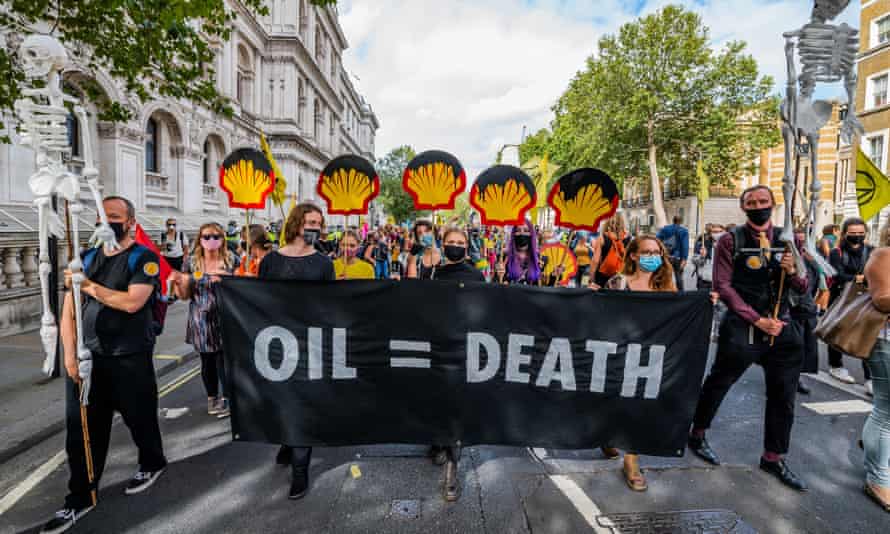Why is life on Earth still taking second place to fossil fuel companies?
Effective action against climate breakdown is near impossible while governments are vulnerable to lawsuits

The human tragedy is that there is no connection between what we know and what we do. Almost everyone is now at least vaguely aware that we face the greatest catastrophe our species has ever confronted. Yet scarcely anyone alters their behaviour in response: above all, their driving, flying and consumption of meat and dairy.
During the most serious of all crises, the UK elected the least serious of all governments. Both the Westminster government and local authorities continue to build roads and expand airports. An analysis by conservation charity WWF suggests that, while the last UK budget allocated £145m for environmental measures, it dedicated £40bn to policies that will increase emissions
Astonishingly, it is still government policy to “maximise economic recovery” of oil and gas from the UK’s continental shelf. According to the government’s energy white paper, promoting their extraction ensures that “the UK remains an attractive destination for global capital”, which is “the best way to secure an orderly and successful transition away from traditional fossil fuels”. It’s hard to imagine a more perverse argument. But when you pursue incompatible aims, the first casualty is logic.
So, as our house burns, the government sends in the tanker trucks to spray petrol on the flames. Doubtless unswayed by the donations the Conservative party has received from oil and gas companies, Boris Johnson appears to be on the point of approving the development of a new oilfield – the Cambo – in the North Sea. Yet, as climate scientists have long explained, there is no realistic prospect of preventing more than 1.5C of global heating unless all new fossil fuel development is stopped. In fact, existing projects need to be retired. Nor can we achieve the government’s official aim of net zero emissions by 2050. This target, incidentally, in another sign of the gulf between knowing and doing, bears no relationship to the temperature goals in the Paris agreement. It urgently needs to be replaced with a more stringent measure, but no one in power is prepared to discuss it.
The same goes for almost every government. As soon as Joe Biden’s green promises collided with business as usual, they collapsed in a crumpled heap. Since he pledged to ban new drilling and fracking on federal lands, his administration has granted more than 2,000 new permits. His national security adviser has demanded that Opec+, the oil cartel, increase production, to reduce the cost of driving the monstrous cars that many Americans still buy. We were told that Biden’s modest talk concealed an appetite for radical action. But talk sets the boundaries of action, and those who promise low deliver lower.
Unless we leave fossil fuels in the ground, any commitment to stop climate breakdown is merely gestural. The atmosphere does not respond to gestures. It is unmoved by promises, unimpressed by words. It has no factions that can be set against each other, no voters who can be fobbed off and distracted.
This is one of the reasons why governments hate and shun what climate science tells them. If they took it seriously, they would tailor policy to scientific advice. But such constraints on political choice are perceived as intolerable, not only by politicians, but by the philosophy on which our democracies are founded.
Or are they? On behalf of commercial interests, governments are all too happy to be constrained. A UK oil company is currently suing the Italian government for the loss of its “future anticipated profits”after Italy banned new oil drilling in coastal waters. Italy used to be a signatory to the Energy Charter Treaty, which allows companies to demand compensation if it stops future projects. The treaty’s sunset clause permits such lawsuits after nations are no longer party to it, so Italy can be sued even though it left the agreement in 2016. This is one of many examples of “investor-state dispute settlement”, that makes effective action against climate breakdown almost impossible. It represents an outrageous curtailment of political choice, with which governments like ours are entirely comfortable. I’m not sure how we can escape such agreements, but government lawyers should be all over this issue, looking for a way out. Otherwise, future corporate profits remain officially more important than life on Earth.
The global emergency requires a new politics, but it is nowhere in sight. Governments still fear lobby groups more than they fear the collapse of our living systems. For tiny and temporary political gains, they commit us to vast and irreversible consequences. MPs with no discernible record of concern for poor people, and a long record of voting against them, suddenly claim that climate action must be stymied to protect them.
The Treasury refuses to commit to the spending needed to support even the government’s feeble programme. Johnson, charged with transforming the global response to climate breakdown at the November summit in Glasgow, blusters and dithers, seeming constitutionally incapable of making difficult decisions.
No government, even the most progressive, is yet prepared to contemplate the transformation we need: a global programme that places the survival of humanity and the rest of life on Earth above all other issues. We need not just new policy, but a new ethics. We need to close the gap between knowing and doing. But this conversation has scarcely begun.
George Monbiot is a Guardian columnist





